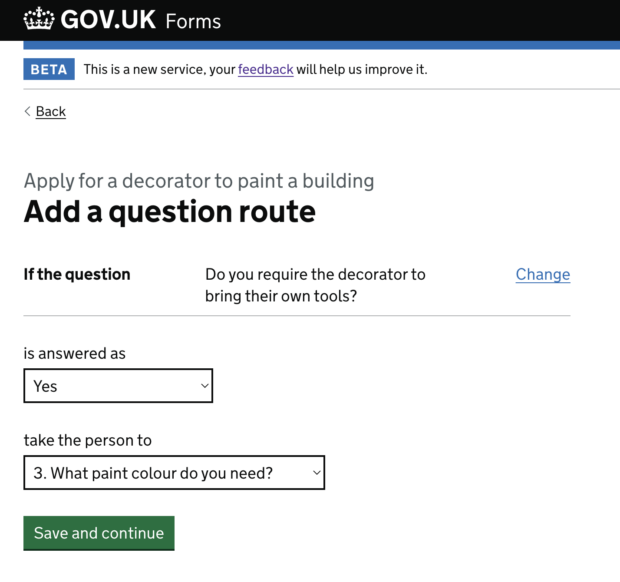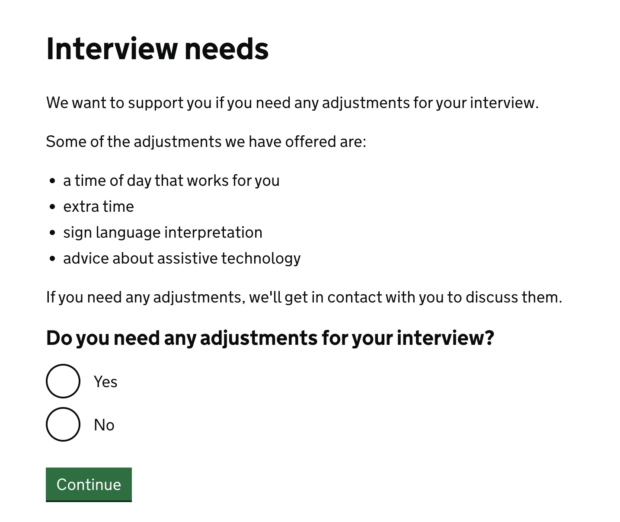
Here at GDS, we’re making it easier for departments to build better digital services. GOV.UK Forms is an online form builder which can be used to make accessible and easy to use digital forms for GOV.UK. It saves time for departments that are processing form submissions, and time for users that are filling in forms.
In just a matter of minutes, government teams can replace PDF and other document-based forms with digital forms which all users can access and are legally compliant with the Public Sector Bodies Accessibility Regulations 2018.
Best of all, there’s no need for any technical knowledge and it’s completely free!
GOV.UK Forms is currently in private beta, where we’re testing the product out with a small number of teams that own forms. This is to help us steadily understand how our product is working and what issues we need to address. After that, we’ll move into public beta, where we’ll open up GOV.UK Forms for any central government department to use freely.
We wanted to share what we’ve been up to since our last update, and what we’re doing to open up private beta for a wider pool of users - a phase that we’re calling ‘Early Access’. This will allow departments with forms that only require current features to start building them, and also allow any government user to try out our product. It will also help us to ramp up our overall user numbers and test the stability of our platform before public beta.
What we’ve done
In October 2022, the Insolvency Service was the first government organisation to publish a form with us. This was a relatively simple form as we only supported quite basic features at the time. The vast majority of document-based forms require more complex features to turn these into digital forms, including multiple options, declaration statements and more.
Routing to skip questions that aren’t relevant
One of these features is routing, or skippable questions. If you think of any form that you might have to fill out, for example at the GP or for an application, the chances are that it will say ‘If you answer ‘No’, skip to question 13’ or similar. This is a really core requirement for form building, and we needed to find a way to build this so that people who aren’t digital professionals could understand how to set up this kind of logic for their form.
We created a new journey for form builders to add this to questions that ask for one answer to be selected from a list of options. They can specify which answer should route people to a future question and which question they should go to. The person filling out the form will then skip questions they don’t need to answer - saving them time and saving processing time too. You can see how this appears for form builders in the screenshot below:

We know this is not going to cover all routing needs though - in the future, we’d like to look at building branching (two separate sets of questions depending on the answer), and later down the line we might be able to expand our routing so you can add routes to more than one answer, and also routes based on a combination of answers.
Making a draft of a live form
At the start of 2023, if one of our users created a form, made it ‘live’ (meaning it can now be put on GOV.UK), and then later on wanted to edit their live form, any change made would be updated on the live form immediately. This would cause issues as form builders may be making multiple changes, or change their mind about what they want to edit. And each time this would happen, people that are filling in the form would be at risk of losing their progress.
So what we did is we made live forms uneditable - instead, if you want to make changes to a live form, you would create a new draft copy of that form. Then you could make all the edits you want, and only make that new version live when you’re happy with all the changes. This new version would automatically replace the existing live form - meaning this change only happens once, and affects a much smaller number of people filling in the form.
Detailed guidance
Our form builder already allows users to add hint text to a question, such as ‘Enter your name as it appears in your passport’. But sometimes on a form there are questions that need a bit more information for someone to answer - for example, specific guidance that they may need to refer to, or industry codes that need to be defined so that the right code is entered.
To do this, in September we released a feature called ‘detailed guidance’ that will allow this more detailed information to be provided to the person filling in the form. Here’s what it will look like for people filling out an example form:

What we still need to do
User management and self-service accounts
Right now we use GOV.UK Signon to allow users to sign into our product and use it. However, each time that a new user wants access, our team has to set that account up. We also can’t give people custom permission levels based on what we want them to be allowed to do (and not do). Signon is currently making improvements to make it more self-serviceable, but this wouldn’t have been ready for us to start expanding.
So last year we decided that we needed to move off of Signon and use Auth0 (also used by Ministry of Justice’s MOJ Forms) for authenticating users, and bring the permission controls into the GOV.UK Forms product itself. We also wanted to create a system so that users could create their own trial accounts without our involvement (self-service), try out the product, and then be easily upgraded to the next permission level in order to make their forms live.
Doing this work is one of our key challenges to adding many more users onto the platform, and we’ve designed an easy flow to allow quick access to the product, whilst also keeping enough control of who can make live forms whilst we’re still in private beta. We also want to ensure we’re following good governance practices and ensure Memorandum of Understandings (MoUs) are agreed before somebody from a department is able to make a form live.
Other features
Before we kick off Early Access, there are some other features that we’re working on to implement, including:
- an analytics page for each form that shows basic analytics such as submission numbers and completion rates
- email confirmations of submission delivery, so that form completers have a record that their submission was received by the department
- an updated product page with a more detailed public roadmap, guidance on the product, and an easier way to send the team support requests
Launch of Early Access
Once we’ve achieved all these things, GOV.UK Forms will be ready for launching into our ‘Early Access’ stage within private beta, with a public beta launch planned for the first half of 2024.
We are planning to start our Early Access period in November 2023, at which point central government departments can start trying out GOV.UK Forms to see what they can make - and if they meet the criteria, we’ll be providing access to make those forms live. This will open up in public beta when departments can provide their own editor access to form creators. As with any agile development process, timescales can shift depending on what we find out along the way, and priorities.
Before we move to public beta, we have some much-requested features that we’ll be working on, including:
- uploading file attachments
- saving form completion progress and returning to where you left off
- paying for services within the form
We’re not currently supporting organisations outside of central government, such as local councils or NHS and Police, but we’re hoping that we can see this scope expand later in 2024 and beyond.
If you’re interested in what we’re up to, please visit our product page and sign up to our mailing list, where we’ll update you when Early Access is launched - and please share with colleagues or any civil servants who may be interested in our form builder.

16 comments
Comment by Graham Noyce posted on
I recently used the form for GOV.UK exemptions. The ability to save the submitted form would be really helpful. I had to save the checklist as a single page web-file before submitting.
Comment by sophiewatson posted on
Hi Graham,
Thanks for letting us know. We are planning to roll out email confirmations in the coming weeks - this won't initially have the answers you've submitted, but we may look at adding that later. But it will at least provide a confirmation that the submission has gone through so that you can follow up with the form processors. Hope this helps.
Comment by Craig Turner posted on
Can you categorically confirm that this will be opened up to local government, and it's just a question of when not if please?
The appetite in local councils it depts would be huge as many are now having to replace outreach/top-level forms/workflow products which are being withdrawn from the supplier.
Other important technical feature suggestion would be for option to post form payload to URL to allow for specialised internal processing/invoking other API calls etc to store to dB etc
Comment by Adam Robertson, Senior Product Manager, GDS posted on
Hi Craig,
Our plan is to eventually extend its use to local government and other organisations. However, there are numerous features still to test and build (including, as you mention, getting submissions in other ways apart from emails), so we’re not able to commit to an expansion date just yet.
But please feel free to register your interest and sign up for updates, we’ll be sure to keep you posted with how that’s going.
Comment by Madeline Hoskin posted on
Hi GDS (and Nova),
If you would like to test in Local Government early in 2024, perhaps to validate your early access findings with independent agile enabled development and design teams - give me a call we are ready and waiting in North Yorkshire and I am very keen to bridge the gap between central and local government!
We should work as one 🙂
Comment by Adam Robertson, Senior Product Manager, GDS posted on
Hi Madeline, we don’t currently have a date in for testing with local government but we will keep you in mind for this.
Thanks,
Adam
Comment by Matthew posted on
> This new version would automatically replace the existing live form - meaning this change only happens once, and affects a much smaller number of people filling in the form.
Can you not have it so that the new form goes live at a separate URL, which your start/front/entry page then goes to, but anyone in the middle of your existing form can carry on using that to completion? Then you wouldn't affect any people at all, which might be important for long or important forms.
Comment by Adam Robertson, Senior Product Manager, GDS posted on
Hi Matthew,
That is one way of approaching it, but it does mean that someone would need to make sure that wherever that form is, its URL is being updated. For some forms this could be just one place (like the GOV.UK start page), but people may have bookmarks to that old URL, or share it amongst colleagues, friends or family. We felt it was more important to make sure that when a form gets updated, all users are getting that update straight away - otherwise we risk users filling out old forms that are no longer needed.
Thanks,
Adam
Comment by Matthew posted on
> That is one way of approaching it, but it does mean that someone would need to make sure that wherever that form is, its URL is being updated. For some forms this could be just one place (like the GOV.UK start page), but people may have bookmarks to that old URL, or share it amongst colleagues, friends or family.
Not wanting to solutionize at you, and sorry if I wasn't clear, but that wasn't what I meant, you wouldn't have to update other URLs anywhere at all. You would have something like, I dunno:
* /form/some-form/start - intro page, this is what anyone would link to or publicise, and always then goes to newest version of the form;
* /form/some-form/v1/page1 - only accessible by POST, otherwise redirects to /form/some-form/start, shows first page of v1 of the form;
* /form/some-form/v2/page1 - only accessible by POST, otherwise redirects to /form/some-form/start, shows first page of v2 of the form.
Then when someone has edited 'some-form' and wishes to publish version 2 of it, it goes live at v2, start updates itself to post to v2, anyone still in the middle of v1 can carry on, and anyone who somehow has booked a middle-v1 URL (though why would they) is taken back to the start (which will then be v2). And then v1 can be removed a short time afterwards once you're happy that no-one is still going through v1.
Comment by Adam Robertson, Senior Product Manager, GDS posted on
Apologies, I understand what you mean now. The feature that we created was primarily built for users to create draft versions of live forms, so they can work separately on any changes they want to make, without those changes being immediately updated to users. One of the side-advantages was that it limited the impact that making those changes would have on users as well.
However, what I think you're referring to is a concept of versioning which we don't have at the moment, so we wouldn't be able to say 'show these users version 1, and those users version 2’. It is something we may implement in the future though. If so, form builders would be able to see what's changed between updates and revert to an old version if necessary - and this would allow us to have no users affected if a form gets updated.
Comment by Alex Young posted on
Is this being open sourced?
Comment by Adam Robertson, Senior Product Manager, GDS posted on
Hi Alex, yes it is open sourced, our repo is https://github.com/alphagov/forms
Thanks,
Adam Robertson
Comment by Alex Young posted on
Fantastic, thank you.
Comment by Nova Constable posted on
Will this ever be made available to local government bodies?
Comment by The GDS Team posted on
Hi Nova, unfortunately we're not currently supporting organisations outside of central government at the moment, but we’re hoping to expand our scope later in 2024 and beyond.
Kind regards,
The GDS Team
Comment by Nova Constable posted on
Thank you - this will be a great option if/when made available to us.